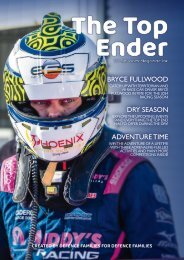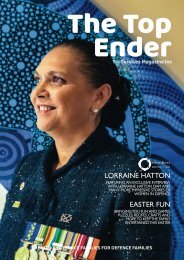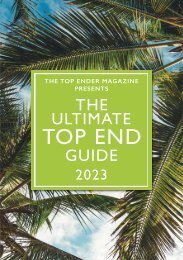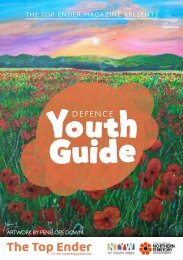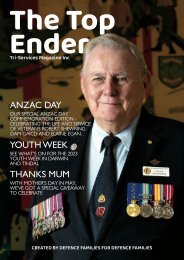The Top Ender Magazine August September 2023 Edition
This edition of The Top Ender Magazine includes competitions, feature interviews, support articles and more. We had the honour to interview Keith Payne, VC AM, the last living recipient of the original Imperial Victoria Cross. We also commemorate significant historical events and acknowledge current events like the Legacy Centenary. Find help and resources that support you to make the most out of your time in the top end of Australia, servicing Darwin, Katherine, Tindal and Pilbara regions.
This edition of The Top Ender Magazine includes competitions, feature interviews, support articles and more. We had the honour to interview Keith Payne, VC AM, the last living recipient of the original Imperial Victoria Cross. We also commemorate significant historical events and acknowledge current events like the Legacy Centenary. Find help and resources that support you to make the most out of your time in the top end of Australia, servicing Darwin, Katherine, Tindal and Pilbara regions.
Create successful ePaper yourself
Turn your PDF publications into a flip-book with our unique Google optimized e-Paper software.
KOOKABURRA KIDS<br />
NT LANDSCAPES<br />
AND WILDLIFE<br />
MIDGE &<br />
MOZZIE<br />
CALENDAR<br />
Volunteer with us<br />
Kookaburra Kids are in need of volunteers to<br />
assist on with their Darwin programs, if you or<br />
anyone you know is interested in becoming a<br />
volunteer please refer to their website<br />
kookaburrakids.org.au/get-involved/volunteer<br />
Online<br />
Connect<br />
Chats<br />
Camps<br />
Contact Mali Booth - 1300 566 525<br />
Community Liaison Officer - Darwin/Katherine<br />
Upcoming NT Camp: Wallaroo 25/8/23<br />
Activity<br />
Days<br />
Need to talk to the Kookaburra Kids team?<br />
Mental<br />
Health<br />
Education<br />
Some parts of the Territory are very<br />
important for wildlife as they have an<br />
unusual richness of species, or particular<br />
groups of endemic or threatened species.<br />
Many of these areas are sites of<br />
conservation significance in the NT.<br />
<strong>The</strong> most important area is the stone country<br />
of western Arnhem Land, which is home to far<br />
more endemic and threatened plants and<br />
animals than anywhere else in the Territory.<br />
This is because it is split into deep gorges, caves,<br />
escarpments and bouldered slopes.<br />
This provides protection from predators, fire and<br />
climatic change.<br />
<strong>The</strong> area supports many relict species that are<br />
either entirely restricted to this area, or have very<br />
small numbers and distributions. Many of these<br />
relict species are hangovers from periods of far<br />
warmer or wetter climates.<br />
Some of the ranges in Central Australia support<br />
large numbers of restricted and endemic species<br />
- Palm Valley is one such place.<br />
Other parts of the Territory are important<br />
because they support abundances of wildlife.<br />
<strong>The</strong> lowlands and floodplains of northern<br />
Australia support large groups of waterfowl,<br />
dense populations of fish and crocodiles, and<br />
many other species.<br />
At Fogg Dam the population of water pythons<br />
has the greatest biomass density for any<br />
terrestrial predator system in the world. <strong>The</strong>ir<br />
main prey item, the dusky rat, is in the order of<br />
15,000 individuals per square kilometre.<br />
In other parts of the NT massive groups of<br />
wildlife are not a permanent feature.<br />
<strong>The</strong> long-haired rat plagues in the Mitchell<br />
grasslands and chenopod shrublands of the<br />
Barkly Tablelands about every 10 to 20 years,<br />
which encourages a similar increase in its main<br />
predators, the letter-winged kite and barn owl.<br />
<strong>The</strong> flock bronzewing is another Mitchell<br />
grassland species that sometimes occurs in large<br />
numbers.<br />
Early explorers described huge flocks of this<br />
pigeon darkening the sky for hours as they flew<br />
over.<br />
Extracted from NT Government<br />
nt.gov.au/environment/animals/about-animals-in-nt<br />
Very high biting<br />
midge peaks<br />
High biting<br />
midge peaks<br />
Moderate biting<br />
midge peaks<br />
Low biting<br />
midge peaks<br />
High mosquito<br />
peaks<br />
Potential for<br />
high mosquito<br />
peaks caused<br />
by rain<br />
Moderate<br />
mosquito peaks<br />
Full Moon<br />
New Moon<br />
REFERENCES<br />
https://hdl.handle.net/10137/12354<br />
https://hdl.handle.net/10137/12355<br />
<strong>August</strong><br />
MON TUE WED THU FRI SAT SUN<br />
1 2 3 4<br />
7 8 9 10 11<br />
<strong>September</strong><br />
MON TUE WED THU FRI SAT SUN<br />
4 5 6 7 8 9<br />
<strong>August</strong><br />
MON TUE WED THU FRI SAT SUN<br />
1 2 3 4<br />
7 8 9 10 11<br />
<strong>September</strong><br />
MON TUE WED THU FRI SAT SUN<br />
1 2<br />
4 5 6 7 8 9<br />
12<br />
3<br />
10<br />
11 12 13 14 15 16 17<br />
18 19 20 21 22 23 24<br />
25 26 27 28 29 30<br />
5<br />
6<br />
13<br />
14 15 16 17 18 19 20<br />
21 22 23 24 25 26 27<br />
28 29 30 31<br />
12<br />
1 2<br />
3<br />
10<br />
11 12 13 14 15 16 17<br />
18 19 20 21 22 23 24<br />
25 26 27 28 29 30<br />
5<br />
6<br />
13<br />
14 15 16 17 18 19 20<br />
21 22 23 24 25 26 27<br />
28 29 30 31<br />
Thank you to the Department of Health for<br />
supplying the calendars of the Salt Marsh<br />
Mosquitos and the Biting Midges. For more<br />
information on either of these pests, visit the<br />
Department of Health’s website.<br />
56 <strong>The</strong> <strong>Top</strong> <strong>Ender</strong> | Tri-Services <strong>Magazine</strong> Incorporated AUGUST/SEPTEMBER <strong>2023</strong> 57




